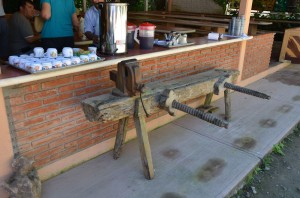We may receive a commission when you use our affiliate links. However, this does not impact our recommendations.
Discussions about the proper height for a workbench always crack me up because they are usually myopic in the extreme.
When you look at workbenches across long periods of time and across cultures, there is a lot more diversity. Roman workbenches, for example, were about knee high. And lest you think that bench went out of style with togas and public baths, think again.
These sorts of benches have never gone away. Check out the 20th-century benches in A. Viires’ “Woodworking in Estonia” or the Mexican bench (above) that reader Lloyd Parker sent me this week from his visit to a coffee plantation.
These benches do all the things that your skyscraper-y bench does. You can work on faces, edges and ends of boards. There are stops. Vises. The only major difference is that you are the holdfast.
And don’t assume these benches were for only crude or green woodworking. A quick survey of the book “Roman Woodworking” by Roger B. Ulrich will change your mind about what is possible on a very low bench.
And don’t even get me started on Chinese workbenches.
— Christopher Schwarz
Here are some supplies and tools we find essential in our everyday work around the shop. We may receive a commission from sales referred by our links; however, we have carefully selected these products for their usefulness and quality.
















Noticed in European (Britain, Scotland, France, Sweden, Germany) paintings of joiners in the 17-1800’s that the benches were about in-seam height. Since it was successful for guys that worked 10 hour days six days a week, I figured it would work for me if I did more woodworking with hand tools instead of power tools. I have a 32″ inseam, so I made my bench 33½” high in 2007. Haven’t got around to making a “Moxon” vise because the vise on the end of my Table saw outfeed table (36″) is high enough to avoid hunching. Lower benches aren’t a recent fad, they are the historical norm for as far back as we have extent examples or illustrations. I don’t think higher benches appeared before the wide spread availability of hand-held power tools.
Roman men were on average ~5’4″ tall. In the West, this did not change substantially until the 20th century.
If anything, the pinky knuckle rule has been the predominant blogosphere fad over the last 4 or 5 years. It is good to see a little push-back. Who knows….we may even see a resurgence of the Scandinavian cabinetmakers workbench. 🙂
That’s an interesting lever-action vice on that Estonian bench
Wait, I thought all benches had to be 38″, and everything else was WRONG WRONG WRONG 🙂
I appreciate the lack of dogma, Chris.
I never felt my bench was too tall or too short. It worked for me, and since it’s the first an only bench I’ve had, I’m used to it.
Until last night. Boring some holes in 3″ ash, I found that my arms were straight out from the shoulder while using my brace. The bench I’m building (number 2 in 20 years) will be lower. I see how a lower bench can be useful, and am glad I’ll have two benched to use. Each will have it’s strengths and weaknesses.
Forgive me for being tall and preferring to stand upright while I work. Then I’ll forgive you for wanting to sit down or hunch over on the job if that’s what you choose to do. Everyone is different, whatever works for the user is ok with me. I don’t see the need to argue over bench heights. 28″ isn’t almost ridiculous for me, it is ridiculous. User mileage may vary. It might be great for someone else. I’m good with that.
If I ever get that shaving horse built I’ll sit down on the job for that one.